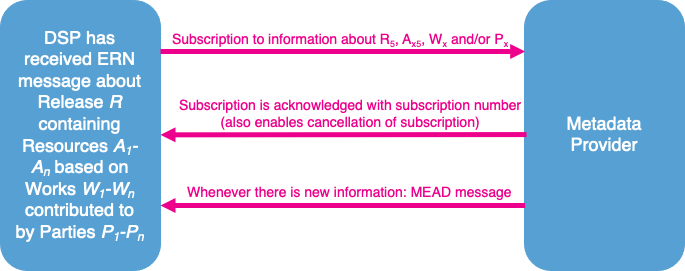MEAD choreography
Who exchanges MEAD messages?
We anticipate there will be two ways in which MEAD messages will be exchanged.
Information is sent as part of an ERN message exchange from a record company or distributor to a DSP. Record companies would be able to send, for example, focus track information to DSPs that support voice-activated services or devices; and
Information is sent from a “metadata provider” to a DSP completely independently of an ERN message exchange. A DSP would subscribe to a metadata feed and would receive such information once new data becomes available.
Metadata providers can include record companies as well as companies that specialise in the aggregation of enriched data about parties, releases, resources and works not normally included in supply chain activities.
How are MEAD messages exchanged?
If a MEAD message is communicated alongside an ERN message, the MEAD message is sent like a resource that accompanies the ERN message. Therefore, neither the sender nor the recipient will need to update the message exchange process they use for exchanging ERN messages. Code will need to be written for creating and ingesting the MEAD message itself.
Where a MEAD message is communicated independently from an ERN message exchange, the process depicted below is envisaged. This process can be implemented using (S)FTP or a web service API similar to the one used today to communicate ERN messages and the associated sound files.
MEAD messages as secondary resources in an ERN feed
One rule of the ERN choreographies is that when one primary Resource file (e.g. the resource files that make up the “essence” of the Release) is to be sent as part of an ERN message, all primary Resources are to be sent. Similarly, when one secondary Resource file (such as a cover art image) is to be sent as part of an ERN message, all secondary Resources are to be sent. This rule was agreed to simplify the logic for ingesting resource files.
MEAD files are communicated, when accompanying an ERN file, as if they were secondary resource files. However, the rule explained above does not apply to MEAD messages. Therefore:
When a MEAD message is to be sent together with an ERN message there is no requirement that the files containing the cover art and any other secondary Resources must also be sent;
When the cover art or any other secondary Resource needs updating, there is no requirement to also update any MEAD message(s);
When updating one MEAD message that was sent with an ERN message, there is no requirement to also update any other MEAD messages that might have been sent with a previous version of the ERN message; and
When updating an ERN message (e.g. to provide a new Deal), there is no requirment to also update all associated MEAD messages. Therefore, MEAD information previously sent with an ERN message about the same Release(s) remains valid unless the sender of the ERN message choses to accompany its updating ERN message with an updated MEAD message. In that case the rules set out in relation to MEAD as a statement of truth.
